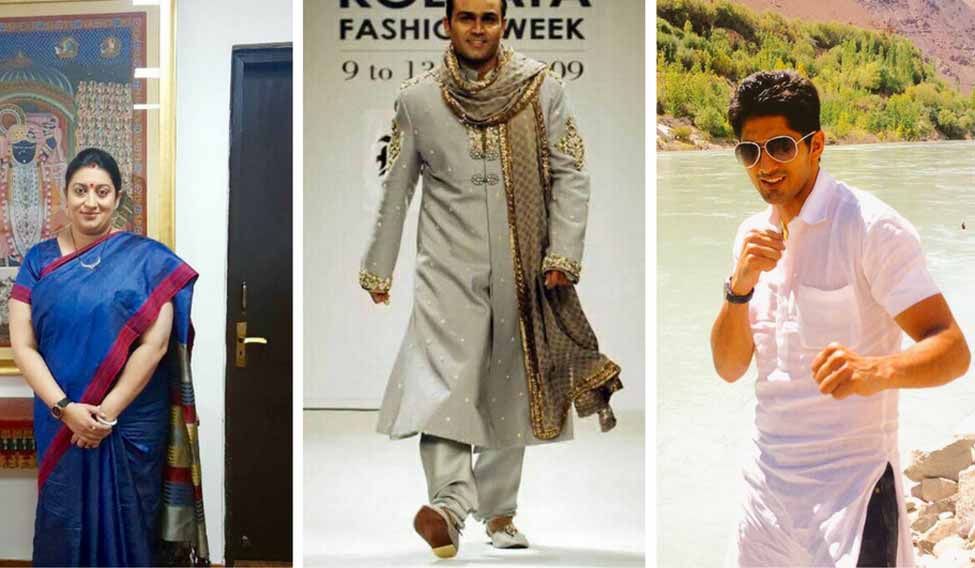Twitter is overwhelmed by colours and pride for Indian handloom industry as people are posting photos of themselves sporting authentic handloom fabric. On August 01, newly-appointed Textiles Minister Smriti Irani came up with the hashtag #IwearHandloom in preparation for the second National Handloom Day on August 7.
She tweeted her photo in a dark blue silk sari, asking followers to do the same and tag five other people.
I support Indian weavers, here's my #IWearHandloom look - Handwoven Silk from Bihar. Share your look & tag 5 people pic.twitter.com/1NOuueJ0mS
— Smriti Z Irani (@smritiirani) August 1, 2016
“#IWearHandloom is a campaign to show support to a community which weaves the diverse fabric of our nation’s rich heritage and bring international fame to our nation,” tweeted Irani.
Handloom gives you an earthy confidence. And so, I am proud to say that #IWearHandloom @TexMinIndia. pic.twitter.com/YFmu4yuqtw
— Divyani Rattanpal (@Divyanie) August 2, 2016
“It is a tribute to women who contribute to 15% of cloth production in India and 95% of world handloom production, it is saying thank you for their hard work and dedication for keeping our traditions alive.”
While the hashtag was trending, the Fashion Design Council of India's president Sunil Sethi, pledged support to the cause.
Cricketer Virender Sehwag and boxing champ Vijender Singh joined the trend and tweeted their photos, garnering many retweets.
Wearing Handloom makes u feel free&gives livelihood to our weavers
— Virender Sehwag (@virendersehwag) August 1, 2016
Handloom pehno,ekdum Free Ho jaao!#IWearHandloom pic.twitter.com/u3L2qfyL5o
Wonderful initiative @smritiirani ji #IWearHandloom because it's one of the best representation of our culture pic.twitter.com/E0fQKuGxEM
— Vijender Singh (@boxervijender) August 1, 2016
#IWearHandloom. Not only worn them all my life but love to enhance weavers' livelihoods by helping create new saris. pic.twitter.com/kp8wxUNgG6
— Jaya Jaitly (@Jayajaitly) August 1, 2016
Among politicians, Kiran Bedi, Jaya Jaitly, Kiren Rijiju, and Jayant Sinha were among the first to join the bandwagon.
With the rise of powerlooms, the Indian handloom industry is in jeopardy. Powerlooms are gaining popularity as faster, cheaper and more productive replacement for handloom. However, it lacks originality and colourful creativity that handloom fabric is known for. A handloom employs more people for various stages of fabric production, including dyeing and weaving, compared to a powerloom. As of now, Indian handloom sector has around 43 lakh workers. Besides this, the environmental impact of powerlooms are much worse than handlooms.
I support Indian weavers. Here's my #IWearHandloom look. Share your look & tag 5 people. @smritiirani @SushmaSwaraj pic.twitter.com/9XzBwo7Pob
— Kiran Bedi (@thekiranbedi) August 2, 2016
Prime Minister Narendra Modi has actively worked on bringing the handloom industry back into the limelight, with proposed initiatives to increase the number of dyeing centres and to provide weavers with subsidised yarn.
#IwearHandloom as any handwoven & handspun Khadi or handloom fabrics made out of cotton, silk or woolen are the best pic.twitter.com/pbYEz56XcE
— Kiren Rijiju (@KirenRijiju) August 1, 2016





